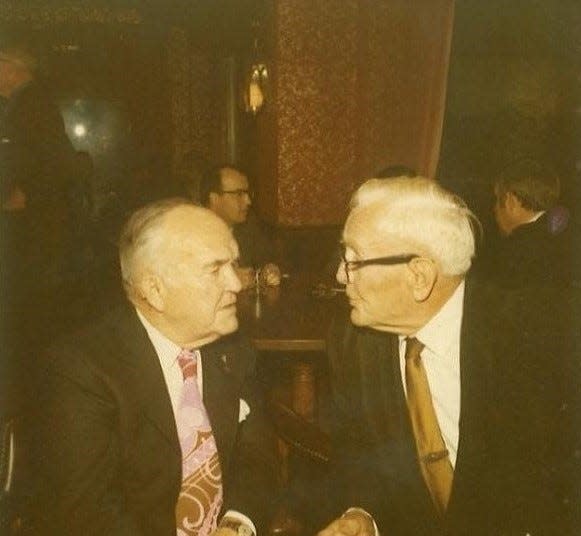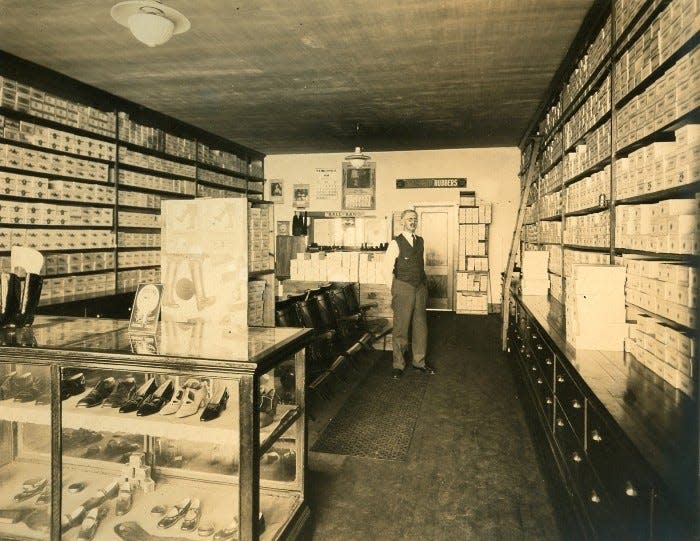Steve VanderVeen: The Geerds and Holland Ladder
The Geerds served their community and their country.
Benjamin Geerds was born in Germany in 1866. He married Susan Bode in 1892. Together, they had three industrious sons: Gerrit, born in 1893, Henry, born in 1894, and Joseph, born in 1897.

By 1910, Benjamin Geerds worked at Steffens Brothers, a neighborhood grocery store at 286 E. 14th St. Gerrit worked at C.L. King and Company, a wooden fruit basket factory, and Henry worked at the Holland Shoe Company. By 1913, Gerrit had joined Benjamin at Steffens Brothers.
The Geerds lived at 288 W. 14th St.
Gerrit later left for Palo Alto, California, where he built homes for silent picture celebrities. By 1915, he'd returned to Holland, where he and Thomas Tasker started the Holland Ladder Company.
Then came World War I, in which Henry Geerds served as a first lieutenant. After the war, he helped establish a National Guard Unit in Holland and build the Holland Armory at 16 W. Ninth St. — all while serving as city treasurer.

In 1926, Gerrit Geerds left his general management role at the Holland Ladder Company to join Frank Bolhuis Lumber and Manufacturing, where he became a director of home planning, architecture and financing. Gerrit and his wife Sarah lived at 75 W. 18th St.
Holland Ladder stayed in the Geerds family. By 1927, Benjamin was president, Gerrit was vice president, and Joseph was secretary-treasurer and general manager. Joseph and his wife Nelle lived at 148 E. 21st St. Holland Ladder was then located at 175 E. 19th St.
But the Geerds had other business interests. In addition to being president of the Holland Ladder Company, Ben and his wife Bertha were proprietors of Geerds’ Shoes at 442 First (now Washington) Avenue (in Washington Square) (present-day Brew Merchant). They now lived at 217 W 16th Street, within walking distance of their store.

Meanwhile, Henry Geerds had co-founded Geerds’ Electric and served as cashier of Holland City State Bank. He and his wife Jean lived at 187 W. 16th St. — close to Benjamin and Bertha.
By 1938, Henry and Jean had moved to 588 Central Ave. and Joseph and Nelle to 574 Lawndale Court. By this time, Henry was serving as secretary-treasurer of the Holland City (Bank) Depositors Corporation, allocating scarce dollars to depositors of the failed bank. (Geerds’ Electric seems also to have failed during the Great Depression.)
Then came World War II. Henry, then almost 50 years old, re-entered active duty and became a lieutenant colonel, leading soldiers — the very ones he'd trained at the Holland Armory — into the jungles of New Guinea, where they built roads. The mission was so dangerous the Japanese wounded Henry three times and most of his men died.
After the war, Henry not only helped form the Holland American Legion, but also two more businesses. One was Holland Hitch, which he purchased out of bankruptcy with Henry Ketel. (Ketel was the inventor of the “pintel hook,” a mechanism for securing and uncoupling of tractor-trailers.) Another was Holland Wire Products, a successor to Karr-Spring Air, a maker of bedsprings.
Subscribe: Get unlimited access to our local coverage
By then, Joseph Geerds was the sole owner of Holland Ladder, which he moved to 430 W. 17th St. — the former site of the Essenburg Building and Lumber Company. (In 1947, Essenburg Lumber Company became DeLeeuw Lumber Company and moved to Lakewood Boulevard.) Sadly, Benjamin Geerds died and, with him, his shoe store.
In the 1960s, there was a new owner at Holland Ladder: Richard Cotter. In the 1970s, Henry Geerds’ son-in-law, William Beebe, became president of Holland Hitch. In 2006, Pamplona Capital, from the United Kingdom, purchased it.
In 2000, Green Bull Ladders of Louisville, Kentucky, purchased Holland Ladder, which continued its manufacturing and distribution of wooden ladders. In 2004, I interviewed Rick Kruid, then serving as Holland Ladder’s general manager, who told me of the risks of the business.
First, the cost of liability suits and protection accounted for 30% of sales. Second, the cost of lumber had driven up the price of Holland’s wooden ladders. Plus, wooden ladders were losing favor with contractors: they were heavier than aluminum ones, and they bounced under loads.
Green Bull shuttered the local plant in 2005. In 2006, Bob Byars of King’s Cove Party Store purchased the building.
Information for this story comes from Robert Swierenga’s "Holland, Michigan" and Rapid Growth Media.
— Steve VanderVeen is a resident of Holland. You may reach him at skvveen@gmail.com. His book, "The Holland Area's First Entrepreneurs," is available at Reader’s World
This article originally appeared on The Holland Sentinel: Holland History: The Geerds and Holland Ladder

